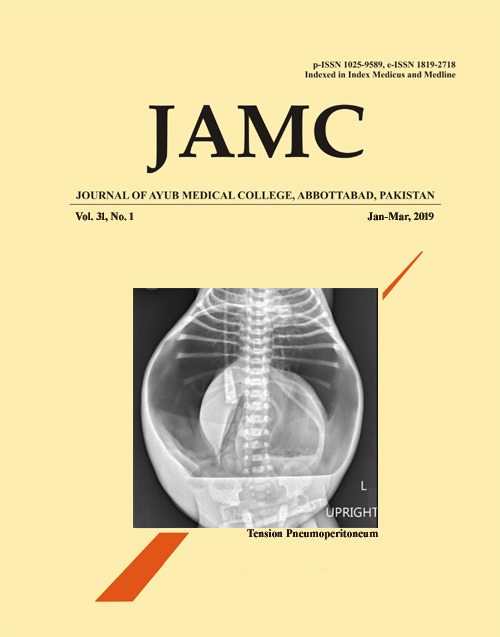FIBRO DYSPLASIA OSSIFICANS PROGRESSIVA
Abstract
We present a case of a 7 years old boy with a very rare debilitating autosomal dominant disorder characterized by heterotopic ossification. Fibro dysplasia ossificans progressiva affects 1 in 2 million individuals with only 2 previous cases reported from this region. The disease manifests as multiple foci of bone formation in muscles, fasciae, tendons and ligaments often triggered by trauma. The child was born with bilateral short hallux valgus and aplasia of distal phalanges of both thumbs. In the last 3 years he had developed hard bony swellings in the scalp, followed by limitation of neck mobility. He developed palpable nodules on the right lateral thoracic cage over the last 1 year following trauma. Heterotopic bone formation was also seen in both tibias. FOP causes irreversible lesions of ossification thus early institution of prophylactic measures, counselling regarding avoidance of trauma and surgery can significantly reduce acute exacerbations of this rare disease.Keywords: Fibro dysplasia ossificans progressive; Heterotopic ossification; Hallux valgusReferences
Vamshi R, Moorthy GVS, Prasad VKV, Vishwanath M, Srinivas C, Vivekananda B. Case Report of Fibrodysplasia Ossificans Progressiva. Indian J Case Reports 2016;2(4):117–20.
Magryta CJ, Kligora CJ, Temple HT, Malik RK. Clinical Presentation of Fibrodysplasia Ossificans Progressiva: Pitfalls in Diagnosis. J Pediatr Hematol Oncol 1999;21(6):539–43.
Zafar A, Maroof SA, Ali Z. A case of fibrodysplasia ossificans progressiva with primary ammenorrhea. KUST Med J 2010;2(2):73–5.
Sferopoulos NK, Kotakidou R, Petropoulos AS. Myositis ossificans in children: a review. Eur J Orthop Surg Traumatol 2017;27(4):491–502.
Al-Salmi I, Raniga S, Al- Hadidi A. Fibrodysplasia Ossificans Progressiva - Radiological Findings: A Case Report. Oman Med J 2014;29(5):368–70.
Hashemi J, Shahfarhat A, Beheshtian A. Fibrodysplasia Ossificans Progressiva: Report of a Case and Review of Articles. Iran J Radiol 2011;8(2):113–7.
Shore EM, Xu M, Feldman GJ, Fenstermacher DA, Cho TJ, Choi IH, et al. A recurrent mutation in the BMP type I receptor ACVR1 causes inherited and sporadic fibrodysplasia ossificans progressiva. Nat Genet 2006;5(38):525–7.
Shaikh N, Arif F. Fibrodysplasia Ossificans Progressiva. J Pak Med Assoc 2011;61(4):397–9.
Raees-Karami SR, Jafarieh H, Ziyayi V, Foumani RS, Aghighi Y. Evaluation of 20 years’ experience of fibrodysplasia ossificans progressiva in Iran: lessons for early diagnosis and prevention. Clin Rheumatol 2012;31(7):1133–7.
Maftei C, Rypens F, Thiffault I, Dubé J, Laberge AM, Lemyre E. Fibrodysplasia ossificans progressiva: bilateral hallux valgus on ultrasound a clue for the first prenatal diagnosis for this condition-clinical report and review of the literature. Prenat Diagn 2015;35(3):305–7.
Deirmengian GK, Hebela NM, O’Connell M, Glaser DL, Shore EM, Kaplan FS. Proximal tibial osteochondromas in patients with fibrodysplasia ossificans progressiva. J Bone Joint Surg Am 2008;90(2):366–74.
Zhang W, Zhang K, Song L, Pang J, Ma H, Shore EM, et al. The phenotype and genotype of fibrodysplasia ossificans progressiva in China: A report of 72 cases. Bone 2013;57(2):386–91.
Pignolo RJ, Shore EM, Kaplan FS. Fibrodysplasia ossificans progressiva: diagnosis, management, and therapeutic horizons. Pediatr Endocrinol Rev 2013;10(Suppl 2):437–48.
Kaplan FS, Shore EM, Glaser DL, Emerson S. The medical management of fibrodysplasia Ossificans Progressiva current treatment considerations. Clin Proc Intl Clin Consort FOP 2011;4:1–100.
Published
Issue
Section
License
Journal of Ayub Medical College, Abbottabad is an OPEN ACCESS JOURNAL which means that all content is FREELY available without charge to all users whether registered with the journal or not. The work published by J Ayub Med Coll Abbottabad is licensed and distributed under the creative commons License CC BY ND Attribution-NoDerivs. Material printed in this journal is OPEN to access, and are FREE for use in academic and research work with proper citation. J Ayub Med Coll Abbottabad accepts only original material for publication with the understanding that except for abstracts, no part of the data has been published or will be submitted for publication elsewhere before appearing in J Ayub Med Coll Abbottabad. The Editorial Board of J Ayub Med Coll Abbottabad makes every effort to ensure the accuracy and authenticity of material printed in J Ayub Med Coll Abbottabad. However, conclusions and statements expressed are views of the authors and do not reflect the opinion/policy of J Ayub Med Coll Abbottabad or the Editorial Board.
USERS are allowed to read, download, copy, distribute, print, search, or link to the full texts of the articles, or use them for any other lawful purpose, without asking prior permission from the publisher or the author. This is in accordance with the BOAI definition of open access.
AUTHORS retain the rights of free downloading/unlimited e-print of full text and sharing/disseminating the article without any restriction, by any means including twitter, scholarly collaboration networks such as ResearchGate, Academia.eu, and social media sites such as Twitter, LinkedIn, Google Scholar and any other professional or academic networking site.









